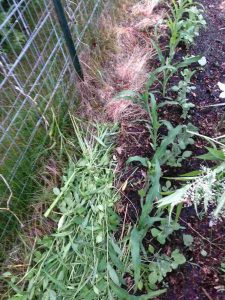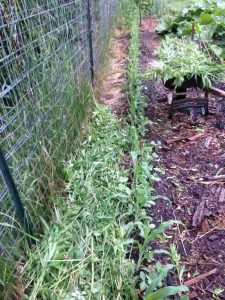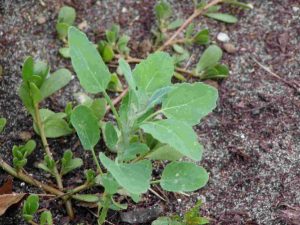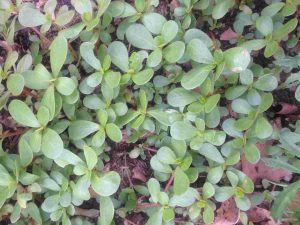Made some good progress in the Popcorn Patch today. Well OK it’s more of a row than a patch; and I’ve interplanted some snow peas and cucumbers. I got the weeds out of a good chunk of the row; then watered thoroughly, then laid some mulch down. For those of you who don’t know, laying mulch down after a good rain (or in this case, watering) will help keep the soil moist; and it also prevents weeds from taking over again. An added bonus is that mulch will also enrich the soil as it decomposes.
For many years, I’ve been mulching with whatever leaves I can get. Come fall, I travel around the neighborhoods with my trailer and pick up as many bags of leaves as I can, This of course has to happen after I help my Honey Pie get the leaves off the lawn at our house.
I didn’t get as many leaves last year as I was hoping; and I’ve used some already. However, I’ll need the rest to make “leaf dust.” I pulverize leaves with our lawn mower and then sift the leaves to get a nice pile of really small particles. That’s the perfect stuff for getting in between the carrot seedlings you see. Anyway, I didn’t want to use up all my leaves, so I pondered a bit on what to use as mulch for the popcorn,
Our trailer is full of wood chips right now for my Beautiful Honey Pie’s ornamental gardens. I’ll use some too, for covering my walkways in the vegetable garden. But since the trailer is full, I won’t be using it to get more mulch right now. During this time of year everyone’s bagged leaves are long gone, so I’ll go after lawn clippings. Those are in bags too, but again, I need the trailer to go get them.
The answer: use weeds for mulch! Say what?? Well you see we are blessed with 5 acres, and although we only use a fraction of it; there are lots of “wild” places where all kinds of things grow. One area behind the vegetable garden is near our pond. I’ve mowed the monster weed growth a couple times; and have even planted some squash down there. But there’s also a large stand of very tall weeds down there.
Today, the light bulb lit up inside my tiny brain. Might as well use those weeds for mulch! So I grabbed the wheelbarrow and the sickle that our Good Friend Mike gave me; and got to hacking weeds. Also cut some new growth off the sumac saplings that were down there. Turned out to be the perfect material for mulching behind the corn. The photos below are not the best quality because I took them with my phone, but you can click them to get a better view.
I showed my beautiful girlfriend my idea and she was a little doubtful. “Won’t they make more weeds?” she asked. A very good question! The key to using weeds for mulch is to: 1) make sure the roots are removed first and Q) make sure you don’t use any weeds that are going to seed. Flowers are OK, but seeds are not so good.
Because the weeds I used are green, they won’t rob any nitrogen from the soil. They may even add some. And the worms will love my offering. And to top it off, all I have to do is wait, and I’ll have plenty of new mulch growing in the back!





